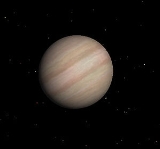
14 Herculis c
Encyclopedia
14 Herculis c or 14 Her c is an extrasolar planet
approximately 59 light-year
s away in the constellation
of Hercules
. The planet was found orbiting the star
14 Herculis
, with a mass that would likely make the planet a gas giant
roughly the same size as Jupiter
but much more massive. This planet was discovered on November 17, 2005 and confirmed on November 2, 2006. According to a recent analysis, the existence of a second planet in the 14 Herculis system is "clearly" supported by the evidence, but the planet's parameters are not precisely known. It may be in a 4:1 resonance
with the inner planet 14 Herculis b
.
Extrasolar planet
An extrasolar planet, or exoplanet, is a planet outside the Solar System. A total of such planets have been identified as of . It is now known that a substantial fraction of stars have planets, including perhaps half of all Sun-like stars...
approximately 59 light-year
Light-year
A light-year, also light year or lightyear is a unit of length, equal to just under 10 trillion kilometres...
s away in the constellation
Constellation
In modern astronomy, a constellation is an internationally defined area of the celestial sphere. These areas are grouped around asterisms, patterns formed by prominent stars within apparent proximity to one another on Earth's night sky....
of Hercules
Hercules (constellation)
Hercules is a constellation named after Hercules, the Roman mythological hero adapted from the Greek hero Heracles. Hercules was one of the 48 constellations listed by the 2nd century astronomer Ptolemy, and it remains one of the 88 modern constellations today...
. The planet was found orbiting the star
Star
A star is a massive, luminous sphere of plasma held together by gravity. At the end of its lifetime, a star can also contain a proportion of degenerate matter. The nearest star to Earth is the Sun, which is the source of most of the energy on Earth...
14 Herculis
14 Herculis
14 Herculis or 14 Her is an orange dwarf star approximately 59 light-years away in the constellation Hercules. Because of its apparent magnitude, the star cannot be seen with the naked eye...
, with a mass that would likely make the planet a gas giant
Gas giant
A gas giant is a large planet that is not primarily composed of rock or other solid matter. There are four gas giants in the Solar System: Jupiter, Saturn, Uranus, and Neptune...
roughly the same size as Jupiter
Jupiter
Jupiter is the fifth planet from the Sun and the largest planet within the Solar System. It is a gas giant with mass one-thousandth that of the Sun but is two and a half times the mass of all the other planets in our Solar System combined. Jupiter is classified as a gas giant along with Saturn,...
but much more massive. This planet was discovered on November 17, 2005 and confirmed on November 2, 2006. According to a recent analysis, the existence of a second planet in the 14 Herculis system is "clearly" supported by the evidence, but the planet's parameters are not precisely known. It may be in a 4:1 resonance
Orbital resonance
In celestial mechanics, an orbital resonance occurs when two orbiting bodies exert a regular, periodic gravitational influence on each other, usually due to their orbital periods being related by a ratio of two small integers. Orbital resonances greatly enhance the mutual gravitational influence of...
with the inner planet 14 Herculis b
14 Herculis b
14 Herculis b or 14 Her b is an extrasolar planet approximately 59 light-years away in the constellation of Hercules. The planet was found orbiting the star 14 Herculis, with a mass that would likely make the planet a Jovian planet roughly the same size as Jupiter but much more massive. It was...
.

